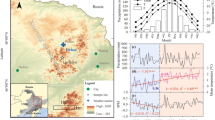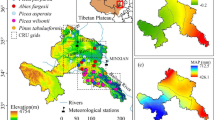Tree-ring width chronologies were developed for Abies veitchii, Betula ermanii and Betula platyphylla var. japonica in their altitudinal ecotone (approximately 1600 m a.s.l.) on Mount Norikura, central Japan, to determine what climatic conditions affect the growth of tree species in the upper and lower distribution limits of an altitudinal ecotone. This altitude was the lower distribution limit for A. veitchii and B. ermanii in the subalpine zone, and was the upper distribution limit for B. platyphylla var. japonica in the montane zone on Mount Norikura. Tree-ring widths of the two Betula species and A. veitchii were positively correlated with the August precipitation of the current and previous years, respectively. Precipitation in August (the hottest month) was reduced compared with other months during summer. Tree-ring width of B. platyphylla var. japonica showed no correlation with temperatures in any month in its upper distribution limit. In contrast, tree-ring widths of B. ermanii and A. veitchii were negatively correlated with the August temperatures of the current and previous years, respectively, at the lower distribution limit of these species. Therefore, the two Betula species and A. veitchii responded to climatic conditions of the current and previous years, respectively. The present study also suggests that a water deficit in August reduces growth of these three species in this altitudinal ecotone, irrespective of the upper or lower distribution limits, and that a high August temperature is more detrimental to the growth of A. veitchii and B. ermanii in their lower distribution limits. Thus, the three species with different altitudinal distributions examined in the present study responded differently to climatic conditions in this altitudinal ecotone on Mount Norikura.
Similar content being viewed by others
References
Abrams M. D. & Orwig D. A. (1995) Structure, radial growth dynamics and recent climatic variations of a 320-year-old Pinus rigita rock outcrop community. Oecologia 101: 353–360.
Camarero J. J. & Gutiérrez E. (1999) Structure and recent recruitment at alpine forest-pasture ecotones in the Spanish central Pyrenees. Ecoscience 6: 451–464.
Cienciala E., Kucera J., Ryan M. G. & Lindroth A. (1998) Water flux in boreal forest during two hydrologically contrasting years; species specific regulation of canopy conductance and transpiration. Annales des Sciences Forestieres 55: 47–61.
Cienciala E., Lindroth A., Cermak J., Hallgren J-E. & Kucera J. (1994) The effects of water availability on transpiration, water potential and growth of Picea abies during a growing season. Journal of Hydrology 155: 57–71.
Cleaveland M. K. (1986) Climatic response of densitometric properties in semiarid site tree rings. Tree-Ring Bulletin 46: 13–29.
Cook E. R. (1985) A time series analysis approach to tree ring standardization. PhD dissertation, University of Arizona, Tucson (unpubl.).
Cook E. R. & Peters K. (1981) The smoothing spline: a new approach to standardizing forest interior tree-ring width series for dendroclimatic studies. Tree-Ring Bulletin 41: 45–53.
Eshete G. & Ståhl G. (1999) Tree rings as indicators of growth periodicity of acacias in the Rift Valley of Ethiopia. Forest Ecology and Management 116: 107–117.
Fritts H. C. (1962) The relation of growth ring widths in American beech and white oak to variations in climate. Tree-Ring Bulletin 25: 2–10.
Fritts H. C., Smith D. G., Cardis J. W. & Budelsky C. A. (1965) Tree-ring characteristics along a vegetation gradient in northern Arizona. Ecology 46: 393–401.
Fujiwara T., Okada N. & Yamashita K. (1999) Comparison of growth response of Abies and Picea species to climate in Mt. Norikura, central Japan. Journal of Wood Science 45: 92–97.
Gervais B. R. & MacDonald G. M. (2000) A 403-year record of July temperatures and treeline dynamics of Pinus sylvestris from the Kola Peninsula, northwest Russia. Arctic, Antarctic and Alpine Research 32: 295–302.
Gindl W. (1999) Climate significance of light rings in timberline spruce, Picea abies, Austrian Alps. Arctic, Antarctic and Alpine Research 31: 242–264.
Gostev M., Wiles G., D’Arrigo R., Jacoby G. & Khomentovsky P. (1996) Early summer temperatures since 1670 A.D. for Central Kamchatka reconstructed based on a Siberian larch tree-ring width chronology. Canadian Journal of Forest Research 26: 2048–2052.
Granier A. & Bréda N. (1996) Modelling canopy conductance and stand transpiration of an oak forest from sap flow measurements. Annales des Sciences Forestieres 53: 537–546.
Granier A. & Loustau D. (1994) Measuring and modelling the transpiration of a maritime pine canopy from sap-flow data. Agricultural and Forest Meteorology 71: 61–81.
Harris S. A. (1978) Vertical zonation of landsnails in the Iraqi slopes of the Persian mountains and in the Rocky Mountains of Alberta, Canada. Arctic and Alpine Research 10: 457–463.
Havranek W. M. & Benecke U. (1978) The influence of soil moisture on water potential, transpiration and photosynthesis of conifer seedlings. Plant and Soil 49: 91–103.
Holmes R. L. (1983) Computer-assisted quality control in tree-ring dating and measurement. Tree-Ring Bulletin 43: 69–78.
Holmes R. L. (1994) Dendrochronology program library, Version 1994. Laboratory of Tree-Ring Research, University of Arizona, Tucson.
Hughes M. K., Schweingruber F. H., Cartwright D. & Kelly P. M. (1984) July–August temperature at Edinburgh between 1721 and 1975 from tree-ring density and width data. Nature 308: 341–343.
Kibe T. & Masuzawa T. (1992) Seasonal changes in the amount of carbohydrates and photosynthetic activity of Pinus pumila Regel on alpine in central Japan. Proceedings of NIPR Symposium of Polar Biology 5: 118–124.
Kienast F., Schweingruber F. H., Bräker O. U. & Schär E. (1987) Tree-ring studies on conifers along ecological gradients and the potential of single-year analyses. Canadian Journal of Forest Research 17: 683–696.
Kikuzawa K. (1983) Leaf survival of woody plants in deciduous broad-leaved forests. 1. Tall trees. Canadian Journal of Botany 61: 2133–2139.
Kimura M. (1963) Dynamics of vegetation in relation to soil development in northern Yatsugatake Mountains. Japanese Journal of Botany 18: 255–287.
Kira T. (1949) Forest Zone of Japan. Ringyogizyutu-kyokai, Tokyo (in Japanese).
Koike T. (1987) The growth characteristics in Japanese mountain birch (Betula ermanii) and white birch (Betula platyphylla var. japonica), and their distribution in the northern part of Japan. In: Human Impacts and Management of Mountain Forests (eds T. Fujimori & M. Kimura) pp. 189–200. Forestry and Forest Products Research Institute, Ibaraki.
Kullman L. (1993) Pine (Pinus sylvestris L.) tree-limit surveillance during recent decades central Sweden. Arctic and Alpine Research 25: 24–31.
Miller B. J., Clinton P. W., Buchan G. D. & Robson A. B. (1998) Transpiration rates and canopy conductance of Pinus radiata growing with different pasture understories in agroforestry systems. Tree Physiology 18: 575–582.
Nagano Meteorological Observatory (1998) Annual Report on Weather Conditions of Nagano Prefecture in 1998. Nagano Branch of Japan Meteorological Society, Nagano (in Japanese).
Oberhuber W., Stumböck M. & Kofler W. (1998) Climate-tree-growth relationships of Scots pine stands (Pinus sylvestris L.) exposed to soil dryness. Trees 13: 19–27.
Ohsawa M. (1995) Latitudinal comparison of altitudinal changes in forest structure, leaf-type, and species richness in humid monsoon Asia. Vegetatio 121: 3–10.
Ohwi J. (1961) Flora of Japan. Shibundo, Tokyo (in Japanese).
Rigling A., Waldner P. O., Forster T., Bräker O. U. & Pouttu A. (2001) Ecological interpretation of tree-ring width and intraannual density fluctuations in Pinus sylvestris on dry sites in the central Alps and Siberia. Canadian Journal of Forest Research 31: 18–31.
Sano Y., Matano T. & Ujihara A. (1977) Growth of Pinus pumila and climate fluctuation in Japan. Nature 266: 159–161.
Schweingruber F. H., Fritts H. C., Bräker O. U., Drew L. G. & Schär E. (1978) The X-ray technique as applied to dendrochronology. Tree-Ring Bulletin 38: 61–91.
Solomina O. N., Muravyev Y. D., Braeuning A. & Kravchenko G. N. (1999) Two new ring width chronologies of larch and birch from the Kamchatka peninsula (Russia) and their relationship to climate and volcanic activities. In: Cryospheric Studies in Kamchatka II (ed. R. Naruse) pp. 111–124. Institute of Low Temperature Science, Hokkaido University, Sapporo.
Sweda T. & Takeda S. (1993) Construction of an 800-year-long Chamaecyparis dendrochronology for central Japan. Dendrochronologia 11: 79–86.
Takahashi K. (1962) Studies on vertical distribution of the forest in middle Honshû. Bulletin of the Government Forestry Experiment Station 162: 1–171 (in Japanese).
Takahashi K. (2003) Effects of climatic conditions on shoot elongation of alpine dwarf pine (Pinus pumila) at its upper and lower altitudinal limits in central Japan. Arctic, Antarctic, and Alpine Research 35: 1–7.
Takahashi K., Homma K., Shiraiwa T., Vetrova V. P. & Hara T. (2001) Climatic factors affecting the growth of Larix cajanderi in the Kamchatka Peninsula, Russia. Eurasian Journal of Forest Research 3: 1–9.
Taylor A. H. (1995) Forest expansion and climate change in the mountain Hemlock (Tsuga mertensiana) zone, Lassen Volcanic National Park, U.S.A. Arctic and Alpine Research 27: 207–216.
Wardle P. (1968) Engelmann spruce (Picea engelmannii Engel.) at its upper limits on the front range, Colorado. Ecology 49: 483–495.
Wilson R. J. S. & Hopfmueller M. (2001) Dendrochronological investigations of Norway spruce along an elevational transect in the Bavarian Forest, Germany. Dendrochronologia 19: 67–79.
Yasue K., Funada R., Fukazawa K. & Ohtani J. (1997) Tree-ring width and maximum density of Picea glehnii as indicators of climatic changes in northern Hokkaido, Japan. Canadian Journal of Forest Research 27: 1962–1970.
Yasue K., Funada R., Kondo T., Kobayashi O. & Fukazawa K. (1996) The effect of climatic factors on the radial growth of Japanese ash in northern Hokkaido, Japan. Canadian Journal of Forest Research 26: 2052–2055.
Yoshino M. M. (1978) Altitudinal vegetation belts of Japan with spatial reference to climatic conditions. Arctic and Alpine Research 10: 449–456.
Author information
Authors and Affiliations
Corresponding author
About this article
Cite this article
Takahashi, K., Azuma, H. & Yasue, K. Effects of climate on the radial growth of tree species in the upper and lower distribution limits of an altitudinal ecotone on Mount Norikura, central Japan. Ecol Res 18, 549–558 (2003). https://doi.org/10.1046/j.1440-1703.2003.00577.x
Received:
Accepted:
Issue Date:
DOI: https://doi.org/10.1046/j.1440-1703.2003.00577.x




